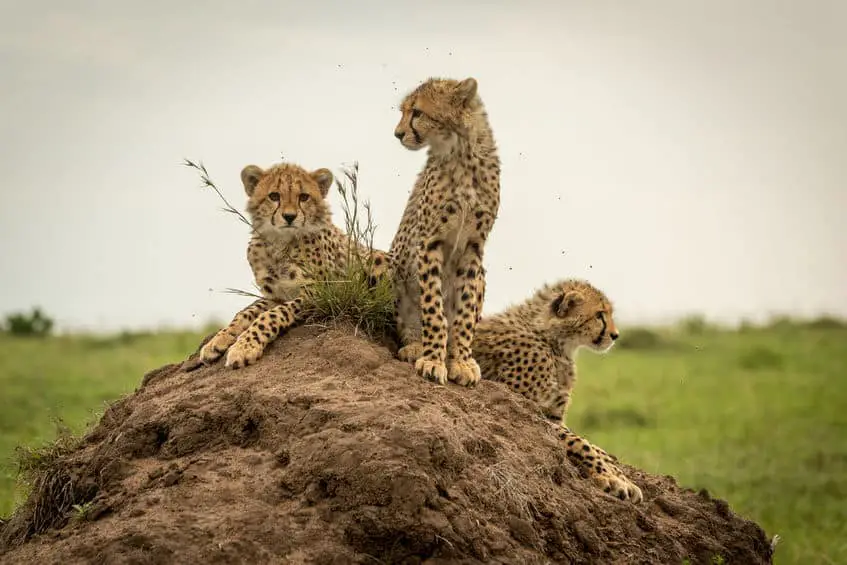
The life cycle of African cheetahs is fascinating. Starting as completely helpless, tiny, blind cubs weighing less than half a kilo and then growing to become the fastest animal on land and one of the most skilled hunters in the world is something only the cheetah can claim to achieve.
In this post, we will explore the life cycle of cheetahs from birth to adulthood.
Newborn Cubs
After a gestation period of 90-98 days, the female cheetah gives birth to her cubs. She will usually have between 3-5 cubs per litter but can sometimes have as many as 9. The mother cheetah will take care of the cubs by herself without the male.
At birth, these newborn cheetah cubs are completely blind and helpless. They weigh only 250-500 grams at birth and are extremely vulnerable. They have silver-colored fur when they are very young but as they grow older, the well-known yellow and orange fur with the very characteristic black spots start to appear and become more and more apparent.
The rate of survival in newborn cheetah cubs can be as low as 5-10% depending on the region. The birth rate in areas with a low population of lions and hyenas, or none at all, is significantly higher than in areas where these predators roam.
The high risk of losing cubs to lions, hyenas, or other large predators is one of the reasons why cheetahs usually have more cubs per litter than other big cats. Leopards and lions each usually have 1-4 cubs per litter and cheetahs usually have 3-5. The risk of losing cubs to these predators is also one of the reasons why the largest cheetah population today is in Namibia in areas outside of national parks where there is no population (or close to none) of lions and hyenas. In these parts of Namibia, you can sometimes be lucky and see coalitions of up to 19 cheetahs.
For the first 5-6 weeks of the cheetah cubs’ life, they will be kept hidden to keep them as safe as possible to increase the chances of survival.
Once the cubs are 5-6 weeks old, their mother will start bringing them with her when she goes hunting for prey but since the cubs are still very young, inexperienced, and playful they actually often end up ruining the hunt for their mother by playing around with each other and being noisy or simply by being bad at hiding or sneaking.
At the age of 3-4 months, they will stop drinking their mother’s milk. At this point, their diet will consist mostly of meat. The same as the adult cheetahs.
After months and months of training and practicing the art of sneaking, sprinting, and hunting, when the young cheetahs are around 15-18 months old, they are starting to get the hang of it and can start hunting and living on their own. At this point, they have reached adolescence.

Adolescence
After reaching adolescence and having acquired the necessary skills to hunt and survive on their own, the young cheetahs will leave their mother and go on to live in a group with both their male and female siblings.
At this point in their life, the young cheetahs are still very vulnerable and at risk of being killed by larger predators. Their hunting success is very low compared to older, more experienced cheetahs so they will have a challenging but extremely instructive time as adolescents.
When the female cheetahs reach sexual maturity at an age of around 2 years, they will leave the group to go on and live on their own. They have reached adulthood.
Adult Life
When they reach adulthood, the female cheetahs will leave their groups to go out and live by themselves while looking for a suitable mate. Unlike the females, male cheetahs stay in their groups with their brothers. This social setup is unique and is not known in any other species of mammals but more on that in the next section.
At this point, the cheetahs are considered to be fully grown adults and are capable of surviving and hunting on their own. Fully grown cheetah males weigh between 30-72 kg. and fully grown females weigh between 20-63 kg. The size of each individual cheetah depends largely on the region they live in and what sources of food are available to them.
Female cheetahs generally live a bit longer than males. The females live to be up to 13 years old but this is on the high end of the scale. On average, female cheetahs live to be a bit more than 6 years old and the males live up to 9 years with an average of a bit over 5 years old. In captivity where cheetahs are not exposed to some of the risks of living in the wild such as predators and where potential illness can be taken care of by their caretakers, they can live for up to as much as 21 years.
After the female cheetahs leave their group of siblings to go live on their own, they will start looking for a suitable mate to start their own families.
After mating, the female cheetah is pregnant for 90-98 days after which she gives birth to her own brand new litter of cubs who then gets to go through the same life cycle.

A Unique Social Structure
I have already mentioned briefly in a previous section of this post, that female cheetahs live on their own and male cheetahs live in groups and now it is time to elaborate on this very unique and fascinating social structure which is not known in any other species of mammals.
For most mammals, the males would usually be the ones to go out and live on their own after they become old enough while females would stay in groups with other females but with cheetahs, this has been turned upside down.
When the female cheetah reaches sexual maturity, she will leave her group and start living on her own while looking for a suitable mate to have cubs of her own. After she gives birth to her cubs, she will stay with them until they are roughly 15 months old at which point they are old enough to take care of themselves.
The males will stick to their group which primarily consists of their biological brothers but they can also form groups with other male cheetahs. Once they have accepted another male cheetah into their group, they will treat it as if it was one of their brothers. These groups usually consist of 2-5 males.
A big advantage the male cheetahs gain by living in these coalitions is the advantage of being able to outnumber prey animals and potentially take on larger prey than otherwise. Groups of male cheetahs have been seen taking down wildebeests, oryxes, or even young giraffes.
Opposite of other cats, female cheetahs have much larger territories than males and their territories will often overlap with other females cheetahs’ territories. Having overlapping territories is not an issue for the female cheetahs who seems to be able to share just fine without getting in fights with each other.
The males on the other hand have much smaller territories. They tend to focus on territories in which their chances of meeting females are increased. This could for instance be areas with a high number of prey animals or with access to water.
Recommended Children’s Book About African Wildlife
If you have kids who like African wildlife and are looking for a book to read with them, or if you are interested in an easy-to-read book full of fascinating information and great photos, I can recommend a great book that I bought recently.
The book I want to recommend is called The Ultimate Book of African Animals by National Geographic Kids. When I first ordered it, I didn’t know what to expect, but I was very pleasantly surprised when I opened it.
The book contains so much fun and interesting information about all our favorite animals from Africa and a lot you probably didn’t even know existed. From tiny lizards to massive mammals, this book covers them all and has beautiful photos of the animals in action.
You can buy the book on Amazon at the link below. It is an affiliate link, so I will earn a commission if you choose to use it.
